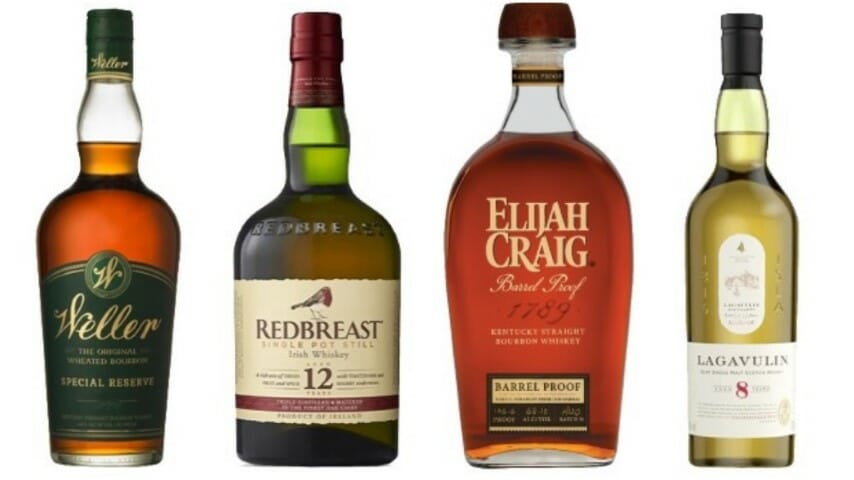
At its heart, a properly stocked bar cart is an all-in-one tool for entertaining. And although our ability to collectively entertain and have people over to our homes has become much more difficult in the era of coronavirus/COVID-19, you can still get the most out of your bar cart by keeping it well stocked for when we finally reach the light at the end of this tunnel.
But what should really be in a well-stocked bar cart? What’s the true function of these rolling mini-bars? In our eyes, a whiskey-focused bar cart should be like a microcosm of the entire whiskey world. It should contain a variety of whiskey styles, such as bourbon, rye, scotch, Irish whiskey and Japanese whisky, if you’re partial to it. It should showcase a range of proofs and price points. It should contain whiskeys that will be useful for a variety of purposes, from basic mixed drinks, to classic cocktails, to neat drinking. And it goes without saying that you’ll also want a variety of mixers, liqueurs and other cocktail ingredients on hand as well.
If there’s one thing you probably shouldn’t find on a bar cart, though, it’s truly rare, exorbitantly priced limited edition bottles, commonly referred to by the whiskey geeks as simply “LEs.” Those prized bottles are probably more comfortable in your liquor cabinet, to be brought out with pomp and circumstance on special occasions. The bar car is more for those bottles you’re reaching for on a daily basis—whiskeys that dependably fill specific roles, and that you don’t feel you have to ration out. If friends come over and you decide to mix up a batch of drinks, the bar cart selections are what you want to have within arm’s reach. Perhaps they’re a bit nicer than what you might use in your personal well for a cheap mixed drink, but they’re also not the stuff you’re saving for a wedding anniversary, either.
So with that said, let’s get to it. I’ve divided these 10 whiskeys up into sub-categories based on the functions they fulfill, and attempted to stick to nationally available brands whenever possible.
1. Very Old Barton Straight Bourbon Whiskey
Function: A cheap value bourbon you can throw in a Coke without it feeling like a waste.
MSRP: $12.99
Alternatives: Benchmark Bourbon, Evan Williams
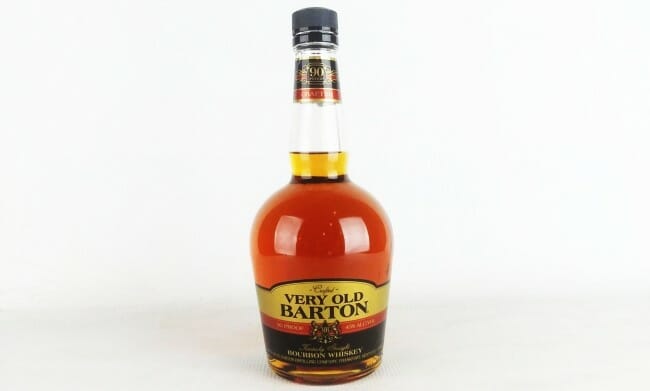
It’s all too easy to fill your bar cart with quality mid-shelf bourbons and realize only then that it doesn’t have anything you really want to use for simple mixing purposes. After all, if you’re just making a whiskey and Coke for someone, do you really want to be pouring from a $50 bottle? Save your money and instead discover what is arguably the best pure value in the bourbon world: Very Old Barton. Back when we conducted a blind tasting of 13 bottom shelf bourbons that cost less than $15, it was the consensus #1 selection, and it could probably beat out many bourbons that retail for twice as much in a similar blind tasting setting. As we wrote then:
On the nose, this feels like a classical, decently aged bourbon: Plenty of caramel, vanilla, some oaky char and a good amount of baking spices (cinnamon, ginger, clove). On the palate it feels slick and moderately viscous, with plenty of peppery rye spice and a growing hint of black cherry that swells on repeated sips. Dare we say, this one actually tastes a bit older than it is, especially in terms of the oak and spice complexity that is present. It has a nice rye character without seeming like a rye whiskey, because it never loses its fullness of body or corny sweetness, all of which make it a joy to drink neat.
Certainly, it’s a great bet to splash into any classic bourbon mixed drink, or simple cocktails. Very Old Barton is available in a number of proofs, but try to aim for the 90 or 100 if you can, as they give you significantly more bang for your buck.
2. W.L. Weller Special Reserve Bourbon
Function: An entry-level wheated bourbon, to illustrate the difference.
MSRP: Supposedly around $25, but likely more in practice.
Alternatives: Maker’s Mark, Larceny
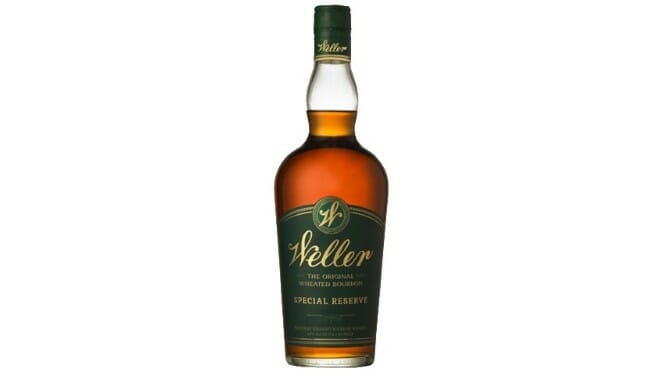
In addition to an affordable, basic bourbon it’s nice to have an affordable, basic wheated bourbon in your bar cart, especially to illustrate the difference between the styles to guests. As the name would suggest, wheated bourbons omit the traditional rye content of bourbon mash bills and instead replace that rye with wheat, which tends to impart a softer, smoother, sweeter character that is often bready/doughy and sometimes floral, rather than the spicier flavor of rye. These are of course generalizations, but the entry-level “wheaters” tend to fit these criteria, and many are decent for both neat drinking or mixing.
Of those bourbons, one of the most sought-after is W.L. Weller Special Reserve, one we recommend you acquire … if you can find it for a fair price. Unfortunately, the bourbon market’s lust for the entire Buffalo Trace catalog, along with the comparison of the W.L. Weller line to the famously sought-after Pappy Van Winkle (another wheater) has resulted in even entry-level bourbons like the W.L. Special Reserve often being jacked way up in price, which means you have to get a bit lucky when shopping. An honest store will still have this stuff priced at around $20-30. Snag it at that price, and don’t get conned into paying $100 for a bottle.
If you can get some, you’ll be rewarded with easygoing flavors of toffee, sourdough, butterscotch and florals. And if you can’t find any, Maker’s and Larceny are more than capable replacements.
3. Rittenhouse Rye
Function: A versatile, affordable cocktail rye whiskey.
MSRP: $25
Alternatives: Old Forester Rye, Elijah Craig Rye, Dickel Rye, Rabbit Hole Rye
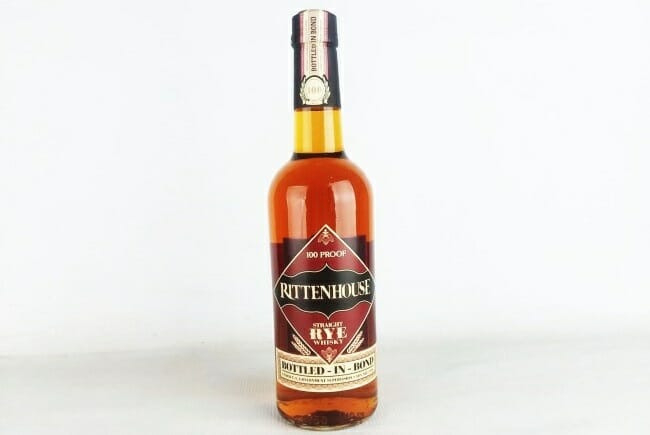
You’ll of course want an affordable cocktail rye on your bar cart, something suitable for mixed drinks (although that’s a bit less common with rye) and everyday classic cocktails such as Old Fashioneds or Manhattans. A higher proof point than the standard 80 proof is a nice feature to have here, as 80 proof ryes (like the ubiquitous Old Overholt) have a tendency to get too diluted as far as our taste is concerned when mixed into a cocktail. Thankfully, the “value rye” demographic has seen some really nice new additions in the last few years, including the new-ish Old Forester Rye and the even newer Elijah Craig Rye.
As far as this pick goes, though, we’re going with the winner of our blind tasting of the best ryes for under $25, which is Heaven Hill’s classic Rittenhouse, a 100 proof, decently aged workhorse that has been a bartender go-to for decades. For any rye-based cocktail you want to whip up on a weekday night, this is as reliable as these picks get. As we wrote when blind-tasting:
It’s significantly thinner of body than richer entries such as the George Dickel, but makes up for that quality with a preponderance of rye-driven flavors. Peppery spice and green apple fruitiness merge with orange peel, grain and earthy rye bread, while the high proof hides itself surprisingly well. Dried fruit, grass and pepper linger on the palate long afterward, rounding out a profile that begs to be mixed into any classic cocktail. For under $25 you can’t do better than this, as far as rye whiskey is concerned.
4. Knob Creek Small Batch
Function: A bigger, more flavorful mid-shelf bourbon for neat drinking.
MSRP: $30-35
Alternatives: Four Roses Small Batch, Elijah Craig Small Batch, Old Forester 1920, Eagle Rare, 1792 Small Batch, Russell’s Reserve, New Riff Straight Bourbon
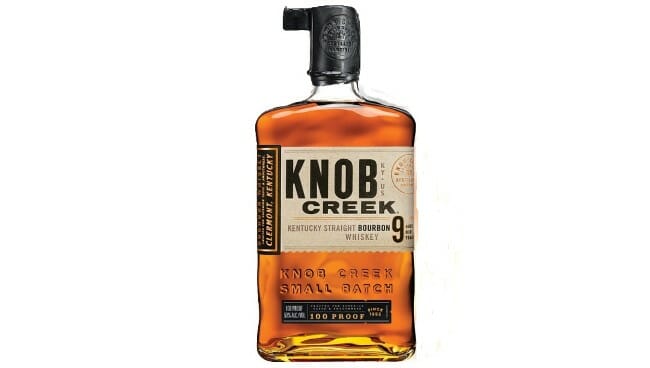
This is where we start stepping it up a bit. With the basics covered—a mixing bourbon, a mixing wheater and a cocktail rye—we can progress into stuff you may use for cocktails, or you may just primarily drink neat, or with your preferred dilution. In bourbon, these all fall into what we’d call the mid-shelf, with the possible exception of the Old Forester 1920, which is in a slightly higher tier. But these are the sorts of bourbons you might turn to for an everyday dram, if you enjoy drinking bourbon neat, or with water, or on the rocks. Which you choose is a matter of personal taste, depending on which distillery’s flavor profile you enjoy.
In this category, Jim Beam’s Knob Creek is one of the old warhorses at this point; one of the first of the “small batch” bourbons and a reliable benchmark of quality. Better yet, after losing its 9 year age statement for a few years between 2016-2020, Beam has recently reinstated that age statement, letting the consumer know that each bottle of KC has been aged at least the full nine years, and bottled at 100 proof, as long as it has the “9” on the label. In terms of flavor profile, it’s a classic expression of the Beam house style: Caramel, vanilla and roasted nuts combine with marshmallow, old oak and slight rye spice for a classic Kentucky bourbon experience.
Better yet: Many high-quality package stores and whiskey boutique shops will have “store picks” of Knob Creek Small Batch or the 120 proof Knob Creek Single Barrel, which represent private barrel selections that are typically excellent values, in addition to being more unique than the standard product. In fact, in this price range be on the lookout for store picks from brands such as Elijah Craig Small Batch and 1792 Small Batch as well.
5. WhistlePig 10 Year Rye Whiskey
Function: A premium rye whiskey for sipping or fancy cocktails.
MSRP: $70-80
Alternatives: Pikesville Rye, E.H. Taylor Rye, High West Rendezvous Rye, Sagamore Spirit Double Oak, Willet Rye
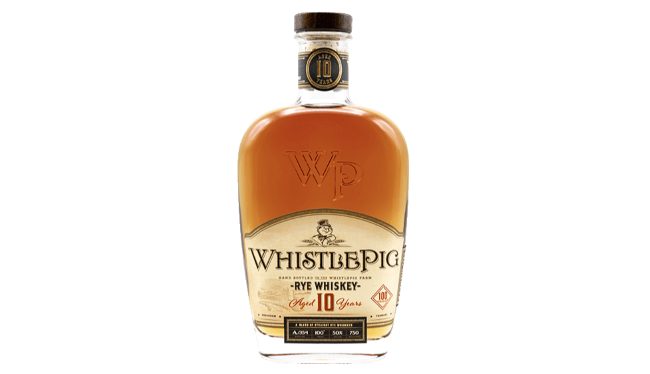
For a weeknight Manhattan, you’ve got your Rittenhouse Rye, and it will get the job done. This position on your bar cart, on the other hand, is reserved for a top-shelf rye, to be consumed however you decide. For us, that would probably be in the form of neat drinking, as we love a nice glass of good rye. Some whiskey geeks primarily see rye as a cocktail foundation, though, and there’s nothing stopping you from using these in classic whiskey cocktails as well … as long as you don’t mind using pricier bottles that way. It’s up to you, but don’t overlook the world of high-quality rye.
WhistlePig is a well-known brand here, and some whiskey geeks like to scoff at it, or the history of the company, but the liquid in the bottle of this flagship rye whiskey is still dynamite stuff. Along with MGP’s widely sourced 95/5 recipe, WhistlePig’s 100% rye whiskey recipe helped change the American conception of what rye whiskey could/should taste like, pushing it away from the older Kentucky style (which was typically around 51% rye) to instead embrace the spicy, complex intensity of the rye grain itself. The result in WhistlePig 10 is rye whiskey that is spicy and decadent in equal measure, with hints of mint, toffee and barrel char, leading into an explosion of baking spice notes that linger for ages on the palate. The price tag may seem a little steep, but as the rest of the premium rye industry has caught up in terms of MSRPs, it actually seems pretty reasonable to us these days. You’re going to want at least one whiskey like this on your bar cart.
6. Elijah Craig Barrel Proof
Function: An intense overproof bourbon for neat drinking or ice.
MSRP: $55-65
Alternatives: Wild Turkey Rare Breed, Booker’s (or just Knob Creek Single Barrel), Four Roses Single Barrel (cask strength store picks)
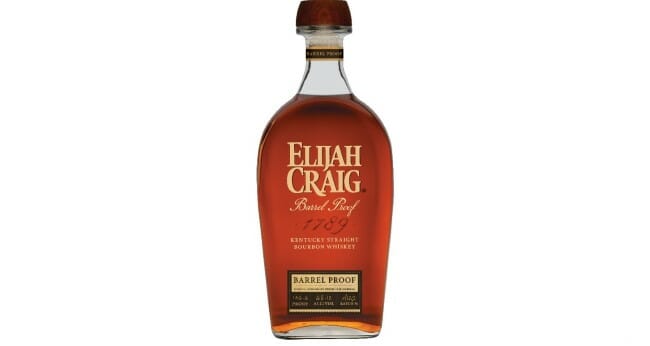
Your bar cart should in no sense be dominated by huge, overproof bourbons, but you’ve got to have at least one on there, right? This is the bottle you pull out at the end of the night for the nightcap, or the one you reach for when you know your guests can handle the intensity of its flavors. It’s how you impress folks, unsurprisingly. You probably won’t be reaching for this bottle quite as often, but it’s arguably the most memorable one on the cart.
With that in mind, you’re not going to do better—especially for the money—than Elijah Craig Barrel Proof, which has for years been one of the most dependably great values in overproof bourbon. Heaven Hill releases three batches of this per year—you can see which one is which via the “A,” “B” or “C” in the batch name—with each batch varying substantially in terms of flavor profile and overall proof. They’re all, however, aged 12 years and often range as high as 130 proof, making them absolute flavor monsters, no matter what batch you manage to find. The flavors of the most recent batch, for instance (A120), explode on the palate with wave after wave of old oak, deep caramel, dark fruit and cocoa, before softening to reveal more vanilla and sweet citrus with a little dilution. And if you know anything about whiskey pricing at all, the average price tag of these bottles ($60-ish, although they can run higher) is something you should recognize is a steal. I’ve counted this as one of my favorite bourbons for a long time, and almost every batch has lived up to my expectations and then some. It’s a no-brainer for the bar cart.
7. Redbreast 12 Single Pot Still Irish Whiskey
Function: A high-end Irish malt whiskey for neat drinking.
MSRP: $55-65
Alternatives: Green Spot Single Pot Still, Egan’s 10 Year Single Malt
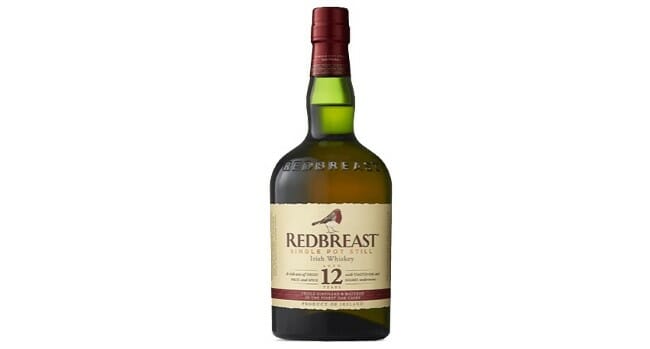
Time to get away from bourbon and rye, and hop across the pond. Irish malt whiskey always gets overlooked because so much of the segment is composed of the cheaper blended whiskeys, but we’re not going to overlook it in this bar cart. These whiskeys are an important jumping off point for drinkers who have run up and down the field of American whiskey and are searching for new experiences, expressly because they have a tendency to be somewhat more inviting than Scottish single malts. They allow one to dip a toe into U.K. malt whiskey in a way that is both approachable and appreciably complex.
In this category, there’s no more respected bottle than Redbreast 12, and it makes it a no-brainer for the bar cart. This is a rare example of “Single Pot Still” Irish whiskey, meaning it’s made from a combination of malted and unmalted barley within a copper pot still, before being aged in re-used whiskey barrels, as is standard in the scotch industry. This process yields complex flavors of fruit, spice and subtle oak, with notes of honeyed sweetness, ginger spice, nutty sherry, shortbread, vanilla and orchard fruits. Basically, it’s like the definition of Irish malt whiskey in a bottle, and it’s indispensable for the bar cart when you want to swing in a different direction than all the caramelized, heavily oaked bourbon you’ve been drinking recently. You’ll also find it has some intriguing cocktail applications, if you go down that road.
8. Arran 10 Year Old Whisky
Function: An approachable, easy to enjoy Scottish malt whisky that anyone will like.
MSRP: $45-55
Alternatives: Glenlivet 12, Glenfiddich 12, Glenmorangie Original, Craigellachie 13
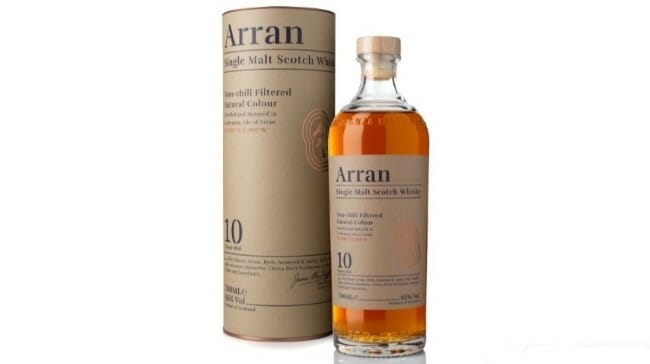
Now we’re into your scotch bottles. The first thing you’ll want on your bar cart is a very approachable, friendly sort of malt—a bottle you can pull out for a friend to sample if they like bourbon or rye but have never really tried scotch. You’re also going to want an unpeated or very lightly peated scotch here as an option for those who don’t enjoy the intense smokiness and earthiness of more heavily peated malts. The expected train of thinking, going by that description, would probably lead most people to classic Speyside single malts from the likes of Glenlivet or Glenfiddich, or a classic Highland malt like Glenmorangie, but I recently tasted one that I’d substitute into this position: Arran 10 Year Old.
Arran 10 is the flagship product of the Isle of Arran distillery, and although many of the Scottish islands produce heavily peated, smoky malts, this one is just the opposite. Rather, it’s a playful, fairly sweet, very citrusy dram that would totally redefine someone’s idea of “scotch” if all they’ve ever sampled is something like Laphroaig or a smoky blended scotch like Dewar’s. This one is the exact opposite, and is a very easy neat drinker. As we wrote in a recent review:
On the palate, Arran 10 Year is approachable but plenty flavorful, with big, sweet notes of vanilla and juicy orange—the whisky personification of a creamsicle. This is one of the most distinctly citrus-forward drams I’ve had in a while, and I can’t help but find it perfectly charming. It’s quite sweet in terms of residual sugar, but not hard to drink, with much more depth than many of the basic 80 or 86 proofers—you really get the sense that the 92 proof helps lift this one above some of its more direct competition. As the palate develops, I get some additional notes—cocoa on the back end, and a warm maltiness not unlike digestive biscuits with hints of cinnamon and nuttiness. Peat, once again, is not to be found here, but there is a modicum of heat to remind you that this is whisky, rather than dessert.
9. GlenDronach 15 Year Revival Single Malt Scotch Whisky
Function: A very rich, desserty, heavily sherried single malt whisky for neat drinking.
MSRP: $70-90
Alternatives: GlenDronach 12, Aberlour 12, Balvenie Doublewood, Glenrothes Whisky Maker’s Cut
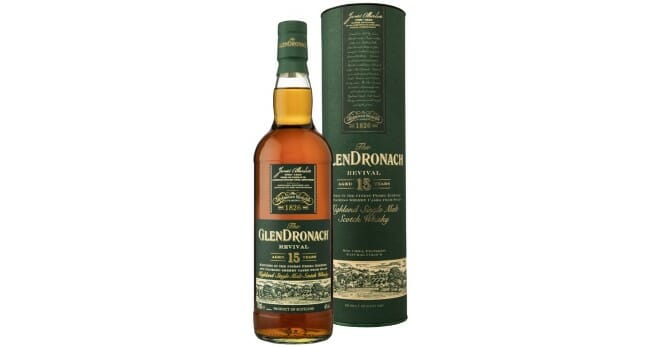
In contrast with a lighter, more refreshing malt, you’re also going to want one that is totally decadent, blowing the doors off in terms of pure flavor. For this, and to go in a more richly fruity, dessert-like direction, we travel in the direction of Scotland’s many sherried single malts. There’s many you could pick here, from the always popular Macallan to other distilleries like Glenrothes and Aberlour that specialize specifically in sherry cask maturation. Our favorite sherried malt factory, however, may very well be GlenDronach, which has become a far more common sight in the U.S. in the last few years. Word has been getting out on these malts, which has unfortunately translated to a bit of price creep. This one in particular, GlenDronach 15, can vary significantly in price from shop to shop, so be aware.
This is a true sherry bomb of a single malt, swimming in flavors of dark fruit, toffee and nutty confections. Note: You could save a few bucks by instead pursuing the slightly cheaper and very pleasant GlenDronach 12, but there’s a pretty big change in sherried intensity and richness between the two that makes the 15 Year Revival a worthy upgrade. If your whisky-drinking friends have sweet tooths or enjoy vinous flavors, they may find this one particularly compelling. As we wrote when revisiting this one recently:
This is very winey and nutty on the nose, with strong notes of nut butter (sweet almond butter) and dark fruit (berry compote) in addition to maple syrup richness and shortbread butteriness. If that sounds like a decadent breakfast to you, you’re not exactly wrong. It’s sweet and commanding on the palate, with cinnamon sugar mixing with that shortbread, almond paste/marzipan and dark berries. I think of this one as more of a dessert dram, but it’s one I’ve become increasingly fond of as I’ve nursed this particular bottle. The oloroso and PX sherry cask aging speaks very strongly through this bottle, and it’s the first scotch that would come to mind if a friend asked me to pick something that really illustrates the flavors of sherry in a single malt scotch.
10. Lagavulin 8
Function: A smoky, peated malt whisky to complete your scotch lineup.
MSRP: $55-65
Alternatives: Lagavulin 16, Laphroaig 10, Laphroaig Quarter Cask, Caol Ila 10
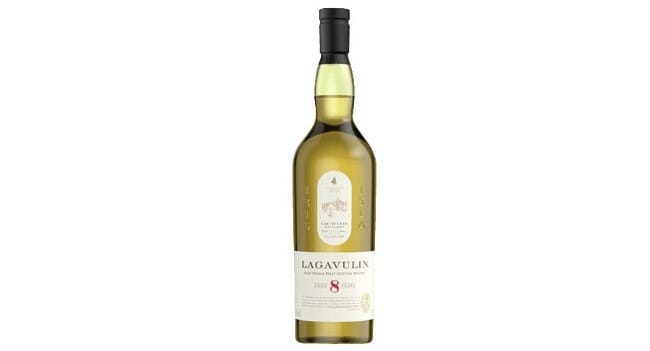
Finally, your bar cart just wouldn’t be complete without at least one peated beast, right? When you’ve got lighter and more decadent malts covered, you’re going to need at least one smoke bomb. Here, you could sub in most of the flagship malts of most of the famous distilleries of the Scottish island of Islay, whether it be Lagavulin, Laphroaig, Ardbeg, Caol Ila or Bowmore, and most of them will be at least predominantly smoky—although there are of course some exceptions at distilleries like Bruichladdich and Bunnahabhain. These malts will be incredibly different from the likes of the preceding GlenDronach, however—deeply earthy, smoky, briny and burnt, with flavors that result from malt kilned via burning Scottish peat. To many people, this is the expected flavor of scotch whisky.
Lagavulin is certainly among the most esteemed distilleries on the island, but after choosing this particular distillery you have to make another choice between two sides of the same coin: Lagavulin 8 and Lagavulin 16. The 16 is the distillery’s classic flagship, and costs a bit more, but the 8 counters by being 10 points higher in proof, sitting at 96 instead of 86. It’s perhaps the more bombastic of the two, reveling in its smoky intensity, along with underlying notes of grainy barley, tropical fruit and sweet malt. It ultimately comes down to preference, but no one would accuse Lagavulin 8 of lacking in character, and its powerful, peaty presence will also shine through in classic cocktails such as the Penicillin, which calls for just enough Islay malt to suffuse it with smoke.
Gather all of these bottles together, and you’ll have a whiskey-oriented bar cart that could surely get you through any crisis, even of pandemic-sized proportions.
Jim Vorel is a Paste staff writer and resident brown liquor geek. You can follow him on Twitter for more drink writing.